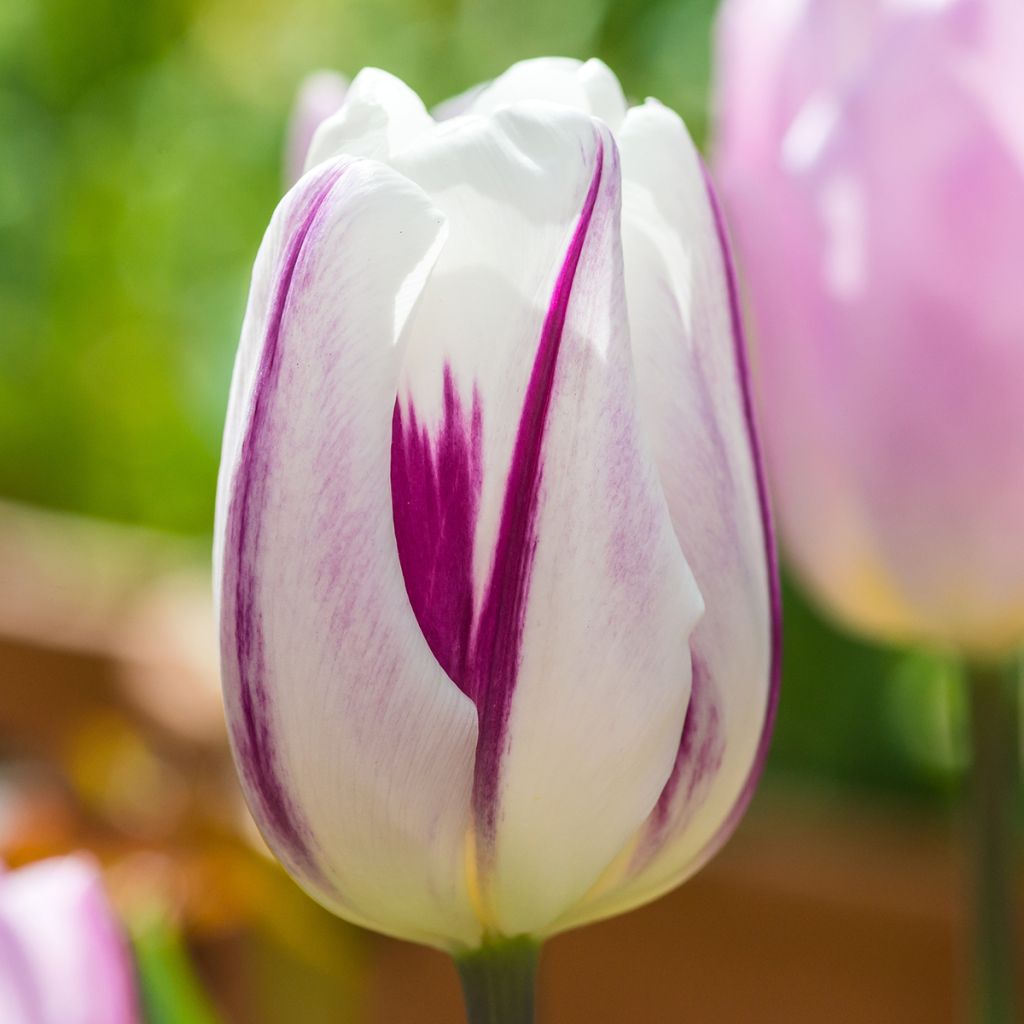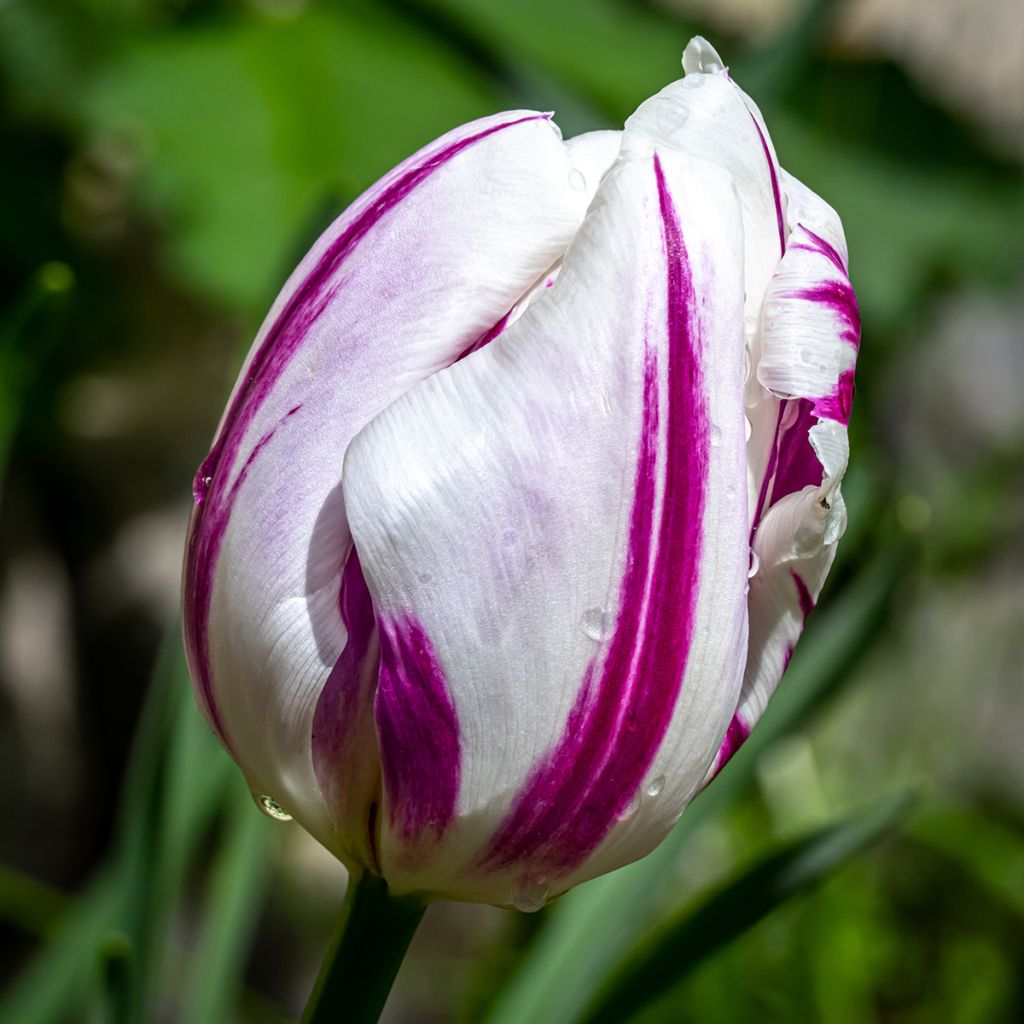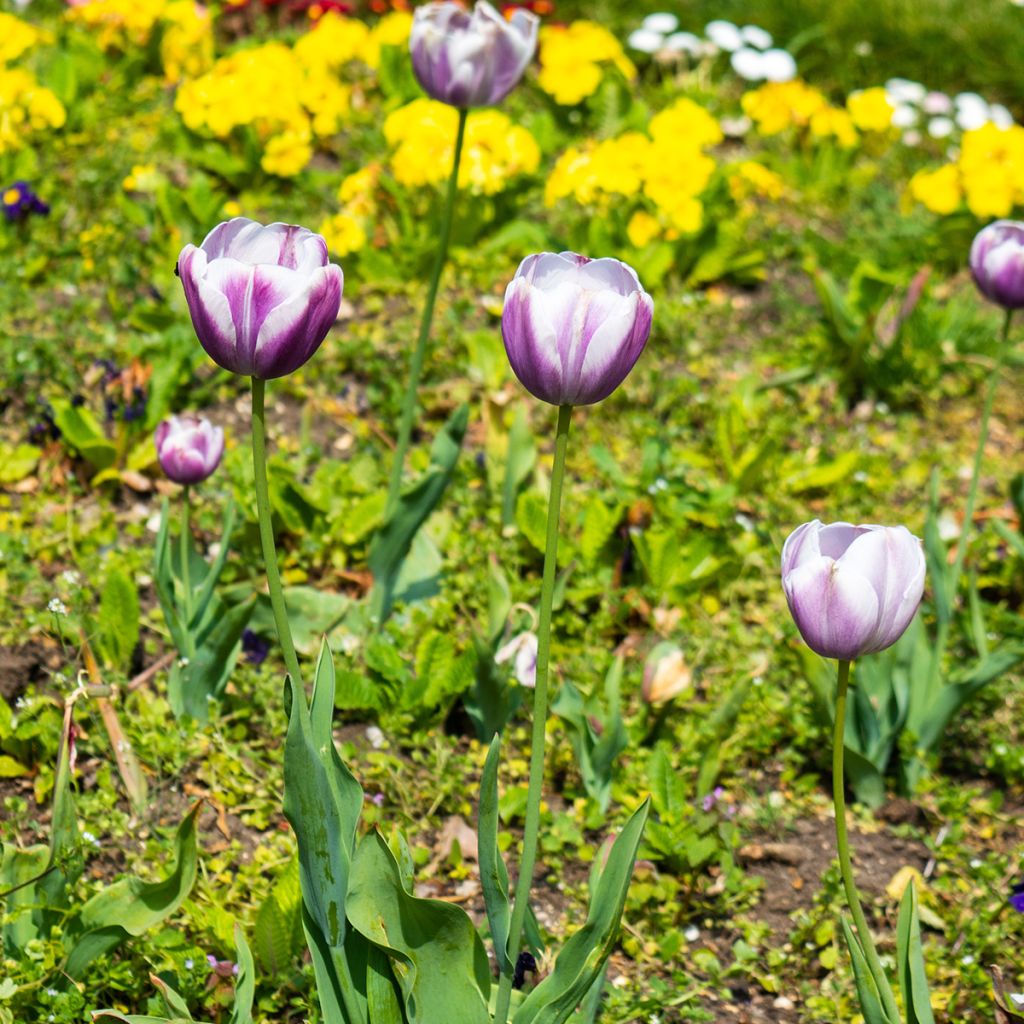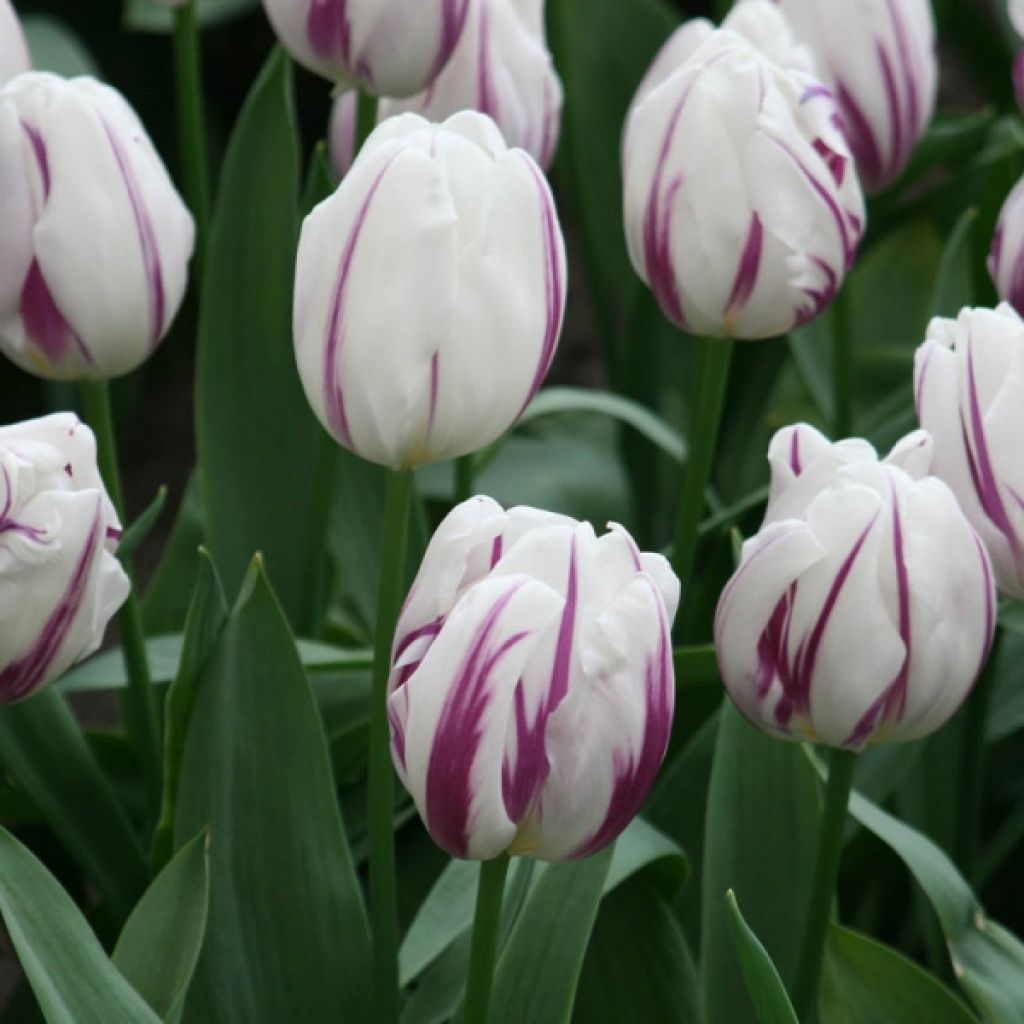

Tulipa Triumph Flaming Flag


Tulipa Triumph Flaming Flag


Tulipa Triumph Flaming Flag


Tulipa Triumph Flaming Flag
Tulipa Triumph Flaming Flag
Tulipa Triumph Flaming Flag
Tulip 'Flaming Flag'
Beautiful and long-lasting flowering, and all the bulbs have taken! Superb and original! In combination with the Arabian Mystery, a very beautiful result!
Isabelle , 24/03/2024
This plant carries a 6 months recovery warranty
More information
We guarantee the quality of our plants for a full growing cycle, and will replace at our expense any plant that fails to recover under normal climatic and planting conditions.
From €5.90 for pickup delivery and €6.90 for home delivery
Express home delivery from €8.90.
Does this plant fit my garden?
Set up your Plantfit profile →
Description
Tulipa 'Flaming Flag' is a sturdy triumph tulip bearing large and magnificent white flowers delicately streaked with light purple. It blooms in April, at the top of a tall stem that withstands wind and rain. Whether in a vase or in a border, it is an elegant and unique variety that does not go unnoticed.
Tulipa 'Flaming Flag' belongs to the Liliaceae family. Of horticultural origin, it was introduced in 2007 in the Netherlands. It is currently classified in the 'Triumph' group, whose main characteristic is to have narrow cup-shaped flowers. Tulips in this group are the result of cross-breeding between early single tulips and late single tulips, and they bloom just after the first ones. The flowers sit at the top of 50cm (20in) high stems, above the widely lanceolate green-blue leaves. The large flowers have 6 "petals," or more precisely, thick and irregularly streaked tepals in violet tones on a white background. Elegant and simple, they are narrow cups measuring about 6cm (2in) in diameter. Flowering takes place around mid-April, in the heart of the tulip season. The foliage dries up and disappears a few weeks after flowering, when the bulb goes into dormancy.
Triumph tulips work well in large borders, or in small groups along a lawn or an alley. 'Flaming Flag' will harmonise perfectly with the solid purple blooms of T. 'Purple Flag', and white narcissus ('Alaska'). The foliage of Heuchera 'Berry Smoothie', a beautiful purplish-pink, will enhance it, as well as the anise green of alchemillas. This beautiful tulip goes well with perennials (brunneras, carex, ferns, hostas), forget-me-nots, dame's rocket, silver basket, and alyssums. The flowers are ideal for creating elegant bouquets. Only use a little water in a vase. If your tulips open too quickly, you can add two to three ice cubes to the vase each day.
Report an error about the product description
Plant habit
Flowering
Foliage
Botanical data
Tulipa
Triumph
Flaming Flag
Liliaceae
Tulip 'Flaming Flag'
Cultivar or hybrid
Planting and care
Plant the bulbs from September to December for a beautiful spring flowering. Choose a sunny or a partially shaded area. Plant the bulbs in well-drained and deeply loosened soil, at a depth of 15cm (6in). Space the bulbs 10cm (4in) apart (making sure they do not touch each other) to achieve a mass effect. Simply water regularly, especially during dry winters. Cut the flower stems after flowering. Allow the leaves to completely dry before cutting them.
Planting period
Intended location
Care
-
, onOrder confirmed
Reply from on Promesse de fleurs
Haven't found what you were looking for?
Hardiness is the lowest winter temperature a plant can endure without suffering serious damage or even dying. However, hardiness is affected by location (a sheltered area, such as a patio), protection (winter cover) and soil type (hardiness is improved by well-drained soil).

Photo Sharing Terms & Conditions
In order to encourage gardeners to interact and share their experiences, Promesse de fleurs offers various media enabling content to be uploaded onto its Site - in particular via the ‘Photo sharing’ module.
The User agrees to refrain from:
- Posting any content that is illegal, prejudicial, insulting, racist, inciteful to hatred, revisionist, contrary to public decency, that infringes on privacy or on the privacy rights of third parties, in particular the publicity rights of persons and goods, intellectual property rights, or the right to privacy.
- Submitting content on behalf of a third party;
- Impersonate the identity of a third party and/or publish any personal information about a third party;
In general, the User undertakes to refrain from any unethical behaviour.
All Content (in particular text, comments, files, images, photos, videos, creative works, etc.), which may be subject to property or intellectual property rights, image or other private rights, shall remain the property of the User, subject to the limited rights granted by the terms of the licence granted by Promesse de fleurs as stated below. Users are at liberty to publish or not to publish such Content on the Site, notably via the ‘Photo Sharing’ facility, and accept that this Content shall be made public and freely accessible, notably on the Internet.
Users further acknowledge, undertake to have ,and guarantee that they hold all necessary rights and permissions to publish such material on the Site, in particular with regard to the legislation in force pertaining to any privacy, property, intellectual property, image, or contractual rights, or rights of any other nature. By publishing such Content on the Site, Users acknowledge accepting full liability as publishers of the Content within the meaning of the law, and grant Promesse de fleurs, free of charge, an inclusive, worldwide licence for the said Content for the entire duration of its publication, including all reproduction, representation, up/downloading, displaying, performing, transmission, and storage rights.
Users also grant permission for their name to be linked to the Content and accept that this link may not always be made available.
By engaging in posting material, Users consent to their Content becoming automatically accessible on the Internet, in particular on other sites and/or blogs and/or web pages of the Promesse de fleurs site, including in particular social pages and the Promesse de fleurs catalogue.
Users may secure the removal of entrusted content free of charge by issuing a simple request via our contact form.
The flowering period indicated on our website applies to countries and regions located in USDA zone 8 (France, the United Kingdom, Ireland, the Netherlands, etc.)
It will vary according to where you live:
- In zones 9 to 10 (Italy, Spain, Greece, etc.), flowering will occur about 2 to 4 weeks earlier.
- In zones 6 to 7 (Germany, Poland, Slovenia, and lower mountainous regions), flowering will be delayed by 2 to 3 weeks.
- In zone 5 (Central Europe, Scandinavia), blooming will be delayed by 3 to 5 weeks.
In temperate climates, pruning of spring-flowering shrubs (forsythia, spireas, etc.) should be done just after flowering.
Pruning of summer-flowering shrubs (Indian Lilac, Perovskia, etc.) can be done in winter or spring.
In cold regions as well as with frost-sensitive plants, avoid pruning too early when severe frosts may still occur.
The planting period indicated on our website applies to countries and regions located in USDA zone 8 (France, United Kingdom, Ireland, Netherlands).
It will vary according to where you live:
- In Mediterranean zones (Marseille, Madrid, Milan, etc.), autumn and winter are the best planting periods.
- In continental zones (Strasbourg, Munich, Vienna, etc.), delay planting by 2 to 3 weeks in spring and bring it forward by 2 to 4 weeks in autumn.
- In mountainous regions (the Alps, Pyrenees, Carpathians, etc.), it is best to plant in late spring (May-June) or late summer (August-September).
The harvesting period indicated on our website applies to countries and regions in USDA zone 8 (France, England, Ireland, the Netherlands).
In colder areas (Scandinavia, Poland, Austria...) fruit and vegetable harvests are likely to be delayed by 3-4 weeks.
In warmer areas (Italy, Spain, Greece, etc.), harvesting will probably take place earlier, depending on weather conditions.
The sowing periods indicated on our website apply to countries and regions within USDA Zone 8 (France, UK, Ireland, Netherlands).
In colder areas (Scandinavia, Poland, Austria...), delay any outdoor sowing by 3-4 weeks, or sow under glass.
In warmer climes (Italy, Spain, Greece, etc.), bring outdoor sowing forward by a few weeks.


































